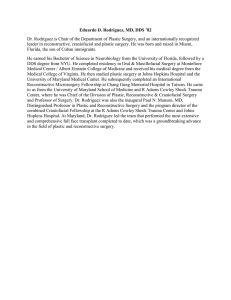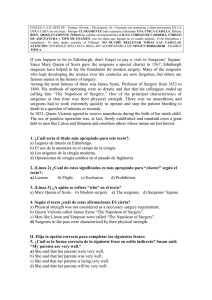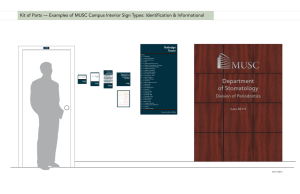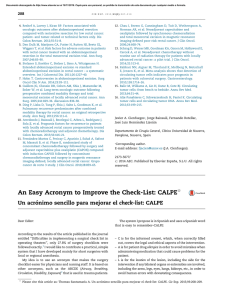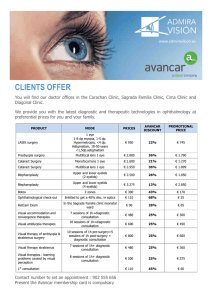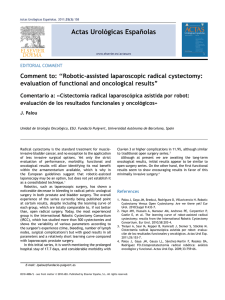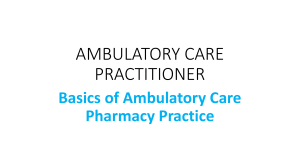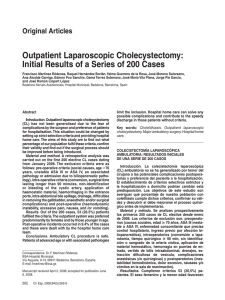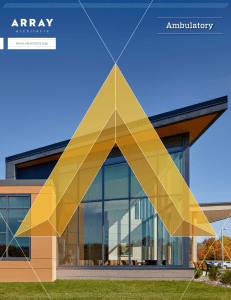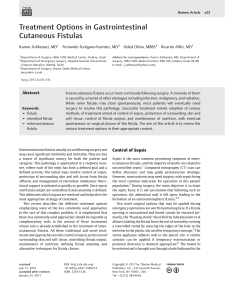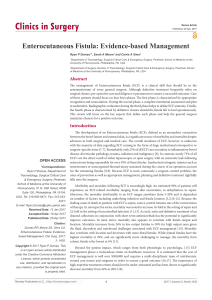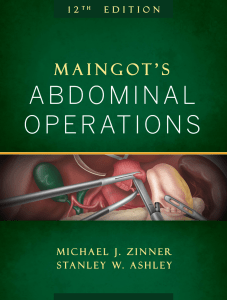Ambulatory Chest Surgery
Anuncio
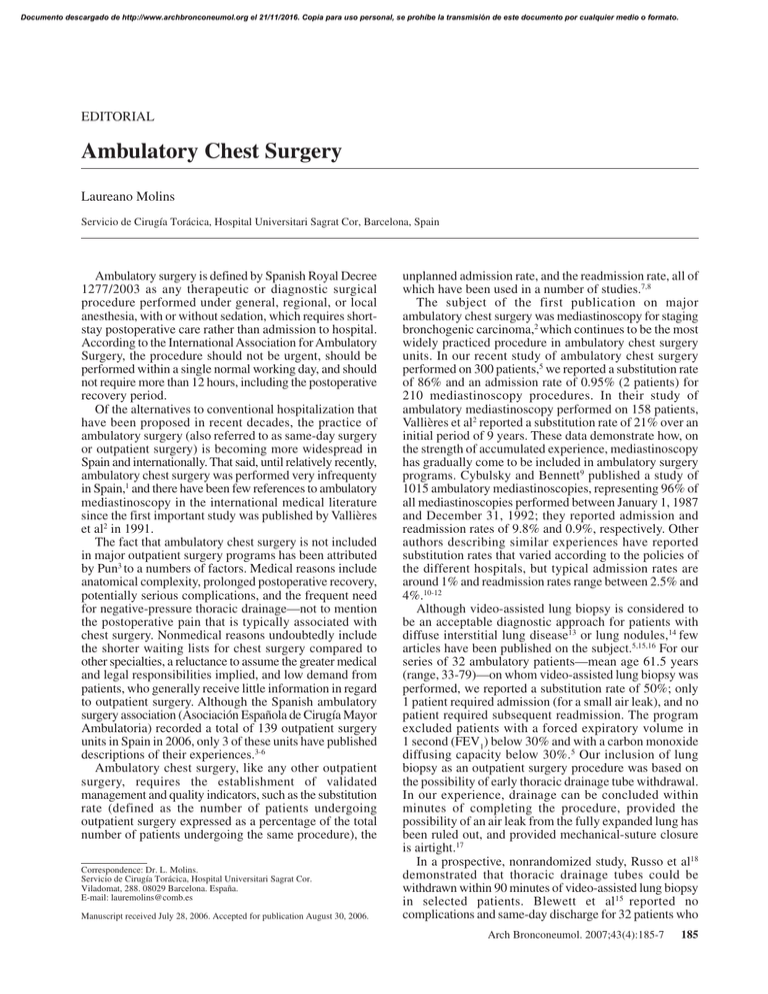
Documento descargado de http://www.archbronconeumol.org el 21/11/2016. Copia para uso personal, se prohíbe la transmisión de este documento por cualquier medio o formato. EDITORIAL Ambulatory Chest Surgery Laureano Molins Servicio de Cirugía Torácica, Hospital Universitari Sagrat Cor, Barcelona, Spain Ambulatory surgery is defined by Spanish Royal Decree 1277/2003 as any therapeutic or diagnostic surgical procedure performed under general, regional, or local anesthesia, with or without sedation, which requires shortstay postoperative care rather than admission to hospital. According to the International Association for Ambulatory Surgery, the procedure should not be urgent, should be performed within a single normal working day, and should not require more than 12 hours, including the postoperative recovery period. Of the alternatives to conventional hospitalization that have been proposed in recent decades, the practice of ambulatory surgery (also referred to as same-day surgery or outpatient surgery) is becoming more widespread in Spain and internationally. That said, until relatively recently, ambulatory chest surgery was performed very infrequenty in Spain,1 and there have been few references to ambulatory mediastinoscopy in the international medical literature since the first important study was published by Vallières et al2 in 1991. The fact that ambulatory chest surgery is not included in major outpatient surgery programs has been attributed by Pun3 to a numbers of factors. Medical reasons include anatomical complexity, prolonged postoperative recovery, potentially serious complications, and the frequent need for negative-pressure thoracic drainage—not to mention the postoperative pain that is typically associated with chest surgery. Nonmedical reasons undoubtedly include the shorter waiting lists for chest surgery compared to other specialties, a reluctance to assume the greater medical and legal responsibilities implied, and low demand from patients, who generally receive little information in regard to outpatient surgery. Although the Spanish ambulatory surgery association (Asociación Española de Cirugía Mayor Ambulatoria) recorded a total of 139 outpatient surgery units in Spain in 2006, only 3 of these units have published descriptions of their experiences.3-6 Ambulatory chest surgery, like any other outpatient surgery, requires the establishment of validated management and quality indicators, such as the substitution rate (defined as the number of patients undergoing outpatient surgery expressed as a percentage of the total number of patients undergoing the same procedure), the Correspondence: Dr. L. Molins. Servicio de Cirugía Torácica, Hospital Universitari Sagrat Cor. Viladomat, 288. 08029 Barcelona. España. E-mail: [email protected] Manuscript received July 28, 2006. Accepted for publication August 30, 2006. unplanned admission rate, and the readmission rate, all of which have been used in a number of studies.7,8 The subject of the first publication on major ambulatory chest surgery was mediastinoscopy for staging bronchogenic carcinoma,2 which continues to be the most widely practiced procedure in ambulatory chest surgery units. In our recent study of ambulatory chest surgery performed on 300 patients,5 we reported a substitution rate of 86% and an admission rate of 0.95% (2 patients) for 210 mediastinoscopy procedures. In their study of ambulatory mediastinoscopy performed on 158 patients, Vallières et al2 reported a substitution rate of 21% over an initial period of 9 years. These data demonstrate how, on the strength of accumulated experience, mediastinoscopy has gradually come to be included in ambulatory surgery programs. Cybulsky and Bennett9 published a study of 1015 ambulatory mediastinoscopies, representing 96% of all mediastinoscopies performed between January 1, 1987 and December 31, 1992; they reported admission and readmission rates of 9.8% and 0.9%, respectively. Other authors describing similar experiences have reported substitution rates that varied according to the policies of the different hospitals, but typical admission rates are around 1% and readmission rates range between 2.5% and 4%.10-12 Although video-assisted lung biopsy is considered to be an acceptable diagnostic approach for patients with diffuse interstitial lung disease13 or lung nodules,14 few articles have been published on the subject.5,15,16 For our series of 32 ambulatory patients—mean age 61.5 years (range, 33-79)—on whom video-assisted lung biopsy was performed, we reported a substitution rate of 50%; only 1 patient required admission (for a small air leak), and no patient required subsequent readmission. The program excluded patients with a forced expiratory volume in 1 second (FEV1) below 30% and with a carbon monoxide diffusing capacity below 30%.5 Our inclusion of lung biopsy as an outpatient surgery procedure was based on the possibility of early thoracic drainage tube withdrawal. In our experience, drainage can be concluded within minutes of completing the procedure, provided the possibility of an air leak from the fully expanded lung has been ruled out, and provided mechanical-suture closure is airtight.17 In a prospective, nonrandomized study, Russo et al18 demonstrated that thoracic drainage tubes could be withdrawn within 90 minutes of video-assisted lung biopsy in selected patients. Blewett et al15 reported no complications and same-day discharge for 32 patients who Arch Bronconeumol. 2007;43(4):185-7 185 Documento descargado de http://www.archbronconeumol.org el 21/11/2016. Copia para uso personal, se prohíbe la transmisión de este documento por cualquier medio o formato. MOLINS L. AMBULATORY CHEST SURGERY underwent open lung biopsy and from whom thoracic drainage tubes were withdrawn immediately after surgery. Chang et al16 published a study of 62 outpatients who underwent video-assisted lung biopsy for the purpose of diagnosing diffuse interstitial lung disease or nonspecific lung nodules. Within 8 and 24 hours of the operation, respectively, 72.5% and 22.5% of patients were discharged. Only 2 patients had to be admitted for persistent air leaks, and just 1 patient had to be subsequently readmitted (for pneumothorax)—representing, respectively, admission and readmission rates of 5% and 1.6%. These results —which confirm our own experience—indicate that videoassisted lung biopsy can be safely and effectively performed on most patients in an outpatient setting, with minimum morbidity. This, in turn, would undoubtedly improve diagnostic rates for patients with diffuse interstitial lung disease. In recent years, video-assisted thoracic sympathectomy has come to be widely used as a treatment for palmar and axillary hyperhidrosis and facial blushing.19 Even though it is generally carried out on young, healthy individuals, a hospital stay of 1 night is usually required as a consequence of pain, nausea, and vomiting. The key to the inclusion of this treatment in an outpatient surgery program, however, is the use of a good anesthesia technique that includes premedication, a general analgesic, intercostal infiltration, and antiemetic agents.20,21 Grabham et al,22 who were the first to describe their experience with outpatients undergoing transthoracic endoscopic sympathectomy, reported an admission rate of 10% for the series of 20 patients. Shortly afterwards, Hsia et al23 described their experience of ambulatory surgery performed on 47 patients with palmar hyperhidrosis; later they reported on 262 patients with axillary hyperhidrosis.24 All but 3 of the operations were bilateral, and no patient required hospitalization. Doolabh et al,25 in a recently published study of 180 outpatient thoracic sympathectomies, reported that just 3 patients (1.7%) had to be admitted. For a series of 309 ambulatory consecutive sympathectomies, Baumgartner and Toh26 reported admission and readmission rates of 0.3% and 1.2%, respectively. In our study,5 once air leaks had been ruled out, drainage tubes were removed in the postoperative recovery room after ambulatory bilateral sympathectomies on 58 patients. None of these patients had to be admitted, and just 1 patient had to be readmitted after 9 days, for drainage of a hemothorax. The results from these studies would indicate that bilateral endoscopic thoracic sympathectomy is a suitable candidate for ambulatory surgery. Taking ambulatory sympathectomies a step further, Elia et al27 recently performed this procedure on 15 patients breathing spontaneously under local anesthesia. Bearing in mind that thoracic drainage is the most important factor in determining whether a patient may be discharged, the indications for an ambulatory chest surgery program can be broadened by developing an early tube withdrawal protocol. Tovar,28,29 of the University of California, has published 2 articles that suggest that ambulatory surgery should even be considered for lung resections. Ambulatory surgery indications could undoubtedly be broadened were chest surgeons to take 186 Arch Bronconeumol. 2007;43(4):185-7 into account the benefits of outpatient procedures, which go beyond the issue of merely reducing the time spent in hospital. A successful ambulatory chest surgery program requires the full commitment of the professionals involved (surgeons, anesthetists, nursing staff, etc), so that they can transmit their confidence in the program to potential patients. A fundamental component of outpatient surgery is anesthesia, which should aim to awaken patients rapidly, so that they can be discharged within a few hours of recovery from surgery with no pain at all or with a level of pain that will not cause undue anxiety. This requires a combined approach to anesthesia that should include inhaled agents (sevoflurane, nitrous oxide), intravenous anesthetic drugs (propofol), short-acting opioids (alfentanil, remifentanil), and short-acting relaxants (atracurium, succinylcholine). Postoperative analgesia should also be administered in the recovery room; meperidine and morphine are not recommended, however, as these drugs delay full recovery of consciousness. The patient should remain in the outpatient surgery unit until discharge criteria have been met, specifically the following: satisfactory blood pressure, oxygen saturation, and heart rate; fully recovered consciousness; satisfactory liquid intake tolerance; ability to walk unassisted; spontaneous micturition; little or no pain; and no signs of exacerbation in associated diseases such as ischemic heart disease or diabetes. Discharged patients should have telephone access to the on-duty anesthetist to be ableto ask about any problems they may experience. The financial costs of major ambulatory surgery should also be considered. In theory, an increase in the percentage of outpatient operations will imply cost savings for the health care system and reduce per-patient costs. The financial impact will depend on a hospital’s standing policy in regard to the stay required for the same procedure performed on admitted patients. In our study of mediastinoscopy, lung biopsies, and sympathectomies,5 savings were minimal, given that we compared the cost of outpatient surgery to the cost of a hospital stay of just 1 day prior to surgery. However, when the outpatient surgery cost was compared to the cost of the mean stay in Spanish hospitals with a similar level of activity, significant savings of €294 per patient were calculated. In our estimate of financial impact, only variable hospital costs were considered, with fixed costs excluded on the assumption that these would be equivalent to those for conventional hospitalization. Also excluded was the real benefit implied by beds being left available for the admission of other patients. In conclusion, despite the growth in ambulatory surgery, the potential for ambulatory chest surgery in Spanish hospitals remains unrealized, even though the use of the video-assisted procedure is well established.30 Crucial to the success of ambulatory chest surgery is that it be introduced in an outpatient surgery unit that is already up and running. Protocols may vary, but inclusion criteria will undoubtedly be added as experience is acquired. The risk of complications possibly going undetected will be minimized if the patient understands and is willing to undergo the ambulatory procedure and has family support, Documento descargado de http://www.archbronconeumol.org el 21/11/2016. Copia para uso personal, se prohíbe la transmisión de este documento por cualquier medio o formato. MOLINS L. AMBULATORY CHEST SURGERY and if telephone and personal postoperative follow-up is provided for. In the future it is likely that pleural effusion diagnosis, localized pleural and mediastinal lesion care, lung and esophageal cancer staging, and solitary lung nodule resections will be included as outpatient surgery procedures, in addition to sympathectomy, mediastinoscopy and video-assisted lung biopsy. REFERENCES 1. Papaceit J, Olona M, Ramón C, García-Aguado R, Rodríguez R, Rull M. Encuesta nacional sobre manejo preoperatorio y criterios de selección de pacientes en las unidades de cirugía mayor ambulatoria españolas. Gac Sanit. 2003;17:384-92. 2. Vallières E, Page A, Verdant A. Ambulatory mediastinoscopy and anterior mediastinotomy. Ann Thorac Surg. 1991;52:1122-6. 3. Pun Y. Parámetros del riesgo quirúrgico. Arch Bronconeumol. 2004; Suppl 5:33-7. 4. Escobar I, López de Castro P, Astudillo J, Fernández, Bassons MJ. Simpatectomía torácica bilateral mediante videotoracoscopia en la hiperhidrosis primitiva realizada en una unidad de cirugía ambulatoria. Arch Bronconeumol. 2003;39 Supl 2:22. 5. Molins L, Fibla JJ, Pérez J, Sierra A, Vidal G, Simón C. Outpatient thoracic surgical programme in 300 patients: clinical results and economic impact. Eur J Cardiothorac Surg. 2006;29:271-5. 6. Varela G, Molins L, Astudillo J, Borro JM, Canalís E, Freixinet J, et al. Experiencia piloto de benchmarking en cirugía torácica: comparación de la casuística e indicadores de calidad en resección pulmonar. Arch Bronconeumol. 2006;42:267-72. 7. Morales R, Esteve N, Carmona A, García F, Sánchez A, Olesti P. Quality indicators in ambulatory surgery. A prospective study. Ambul Surg. 2000;8:157. 8. Martín López MA, Fortuny GO, Riera FO, Grau LH, Maeso MP. Effectiveness of a clinical guide for the treatment of postoperative pain in a major ambulatory surgery unit. Ambul Surg. 2001;9:33-5. 9. Cybulsky IJ, Bennett WF. Mediastinoscopy as a routine outpatient procedure. Ann Thorac Surg. 1994;58:176-8. 10. Souilamas R, D’Attellis N, Nguyen-Roux S, Giomborani R. Outpatient video-mediastinoscopy. Interactive Cardiovasc Thorac Surg. 2004;3:486-8. 11. Venuta F, Rendina EA, Pescarmona EO, de Giacomo T, Flaishman I, Guarino E, et al. Ambulatory mediastinal biopsy for hematologic malignancies. Eur J Cardiothorac Surg. 1997;11:218-21. 12. Bonadies J, D’Agostino RS, Ruskis AF, Ponn RB. Outpatient mediastinoscopy. J Torac Cardiovasc Surg. 1993;106:686-8. 13. Kadokura M, Colby TV, Myers JL, Allen MS, Deschamps C, Trastek VF, et al. Pathologic comparison of video-assisted thoracic surgical lung biopsy with traditional open lung biopsy. J Thorac Cardiovas Surg. 1995;109:494-8. 14. Hazelrigg SR, Magee MJ, Cetindag IB. Video-assisted thoracic surgery for diagnosis of the solitary lung nodule. Chest Surg Clin North Am. 1998;8:763-74. 15. Blewett CJ, Bennett WF, Miller JD, Urschel JD. Open lung biopsy as an outpatient procedure. Ann Thorac Surg. 2001;71:1113-5. 16. Chang AC, Yee J, Orringer MB, Iannettoni MD. Diagnostic thoracoscopic lung biopsy: an outpatient experience. Ann Thorac Surg. 2002;74:1942-6. 17. Fibla JJ, Molins L, Simón C, Pérez J, Vidal G. Retirada precoz del drenaje torácico tras biopsia pulmonar por videotoracoscopia en 146 pacientes. Arch Bronconeumol. 2006;42 (Espec Congr):126-7. 18. Russo L, Wiechmann RJ, Magovern JA, Szydlowski GW, Mack MJ, Naunheim KS, et al. Early chest tube removal after video-assisted thoracoscopic wedge resection of the lung. Ann Thorac Surg. 1998;66:1751-4. 19. Molins L, Simón C, Buitrago J, Vidal G. Tratamiento quirúrgico de la hiperhidrosis palmar y axilar. Arch Bronconeumol. 2003;39 Supl 6:50-6. 20. Duarte JB, Kux P, Castro CH, Cruvinel MG, Costa GR. Fast track endoscopic thoracic sympathicotomy. Clin Auton Res. 2003;13 Suppl 1:163-5. 21. Cruvinel MG, Duarte JB, Castro CH, Costa JR, Kux P. Multimodal approach to rapid discharge after endoscopic thoracic sympathectomy. Acta Anaesthesiol Scand. 2005;49:238-42. 22. Grabham JA, Raitt D, Barrie WW. Early experience with day-case transthoracic endoscopic sympathectomy. Br J Surg. 1998;85:1266. 23. Hsia JY, Chen CY, Hsu CP, Shai SE, Yang SS. Outpatient thoracoscopic limited sympathectomy for hyperhidrosis palmaris. Ann Thoracic Surg. 1999;67:258-9. 24. Hsia JY, Chen CY, Hsu CP, Shai SE, Yang SS, Chuang CY. Outpatient thoracoscopic sympathicotomy for axillary osmidrosis. Eur J Cardiothorac Surg. 2003;24:425-7. 25. Doolabh N, Horswell S, Williams M, Huber L, Prince S, Meyer DM, et al. Thoracoscopic sympathectomy for hyperhidrosis: indications and results. Ann Thorac Surg. 2004;77:410-4. 26. Baumgartner FJ, Toh Y. Severe hyperhidrosis: clinical features and current thoracoscopic surgical management. Ann Thorac Surg. 2003;76:1878-83. 27. Elia S, Guggino G, Mineo D, Vanni G, Gatti A, Mineo TC. Awake one stage bilateral thoracoscopic sympathectomy for palmar hyperhidrosis: a safe outpatient procedure. Eur J Cardiothorac Surg. 2005;28:312-7. 28. Tovar EA. Minimally invasive approach for pneumonectomy culminating in an outpatient procedure. Chest. 1998;114:1454-8. 29. Tovar EA. One-day admission for major lung resections in septuagenarians and octogenarians: a comparative study with a younger cohort. Eur J Cardiothorac Surg. 2001;20:449-54. 30. Molins L. Cirugía videotoracoscópica en el año 2000. Med Clin (Barc). 2000;114:336-8. Arch Bronconeumol. 2007;43(4):185-7 187
